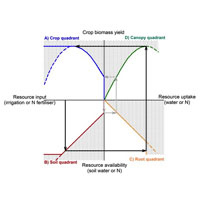Deconstructing agronomic resource use efficiencies to increase food production

Accepted: 8 March 2021
PDF: 461
Supplementary material: 96
Supplementary data: 251
All claims expressed in this article are solely those of the authors and do not necessarily represent those of their affiliated organizations, or those of the publisher, the editors and the reviewers. Any product that may be evaluated in this article or claim that may be made by its manufacturer is not guaranteed or endorsed by the publisher.
Food production per unit land area needs to be increased, thus cropping systems need to use nutrients, water and solar radiation at as close to maximal efficiencies as possible. We deconstruct these efficiencies into their components to define a theoretical crop ideosystem, in which all resource use efficiencies are maximised. This defines an upper biological limit to food production. We then quantify the difference between maximum use efficiencies and those observed in three agronomic systems (maize, cocksfoot, sugarcane) and identify how, in actual farm systems, efficiencies can be raised to raise food production. We find that crop nutrient use efficiency can be limited by low water availability; thus adding nutrients would not raise production but adding water would. The converse situation of water use efficiency being affected by nutrition is not as evident. Ideosystem thinking can be used to define small- and large-scale agronomic systems that optimize water and nutrient use to maximise food production.
Highlights
- Novel ideosystem method of analysing processes of food production, focussing on resource use efficiencies.
- Interactions between resource use efficiencies are asymmetrical.
- The ideosystem concept portrays how far a production system approaches maximum efficiency.
How to Cite

This work is licensed under a Creative Commons Attribution-NonCommercial 4.0 International License.
PAGEPress has chosen to apply the Creative Commons Attribution NonCommercial 4.0 International License (CC BY-NC 4.0) to all manuscripts to be published.

 https://doi.org/10.4081/ija.2021.1694
https://doi.org/10.4081/ija.2021.1694



